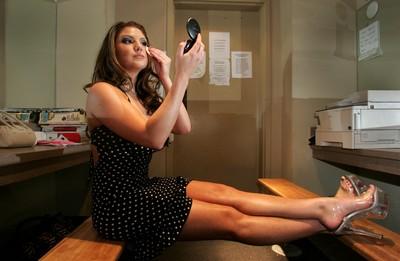Undressed for Success





The morning scene in Courtney Rogalski and Brendan Thorson’s Las Vegas home is one of upper middle-class domestic bliss, the sort that is played out in countless homes across the country.
About 10:30 a.m. on a recent day off, they make their way to the kitchen to cook breakfast: four eggs, four waffles and two pieces of toast for him; eggs over-easy and toast for her; coffee for both of them. Rogalski, ever mindful of her diet, eats around the yolk. Their dogs, Nina and Bubby, bounce around the room, alternating between playing and begging at the table.
After finishing, the couple wash their dishes before planting themselves at their makeshift desk, the dining room table. Thorson, 30, surfs the Internet for a new cell phone; Rogalski, 24, reads e-mail.
These young professionals say they work hard for what they have: a new house in the southwest valley, a Mercedes-Benz and BMW, Thorson’s Prada sunglasses. They own many of the typical trappings of the American Dream.
Their profession, however, is anything but typical. Thorson and Rogalski are strippers.
In Las Vegas, being an exotic dancer or stripper is, to many, just another job. But it comes with a lot of baggage, stereotypes that often are deserved, Rogalski says. Illegal drugs and dancers performing sex acts for money are two of the industry’s biggest problems, she says. Then there’s the stigma that comes from being associated with the field.
“There’s definitely that element that defines the stereotype,” Rogalski says. “It gives the whole industry a bad name.”
But Rogalski and Thorson say they are just like any other young professional couple making a home together and working to build a solid future, despite that baggage.
“It’s part of dealing with the job,” Rogalski says, adding that a stripping income affords them the kinds of things that many people only dream about. “It’s more than we’d make anywhere else.”
She says this despite the fact that both are educated. Rogalski dropped out of college a year and a half shy of a degree in biochemistry while Thorson holds a bachelor’s degree in marketing.
Though they wouldn’t divulge their incomes, Rogalski says an experienced dancer can make $1,000 to $5,000 a night in the clubs. She sometimes works at Scores but mostly does bachelor parties for Sin City Strippers, where she makes a flat fee plus tips. Thorson serves as her bouncer. While they’ve never encountered trouble, the prospect always is there because alcohol is involved, she says.
Thorson also does bachelorette parties for Sin City Strippers, in addition to work online. For the past year, he has operated Dean’s World, a Web site where he offers such services as fitness training, live chats and parties. He also has a Webcam on iFriends.com, mostly targeting the gay consumer.
Many male strippers are uncomfortable with their gay fans, Thorson says, but he sees them as just another way to generate revenue.
“A lot of the guys, if they do it, they think it makes them gay. But I’m comfortable with who I am. And it’s just a job,” says Thorson, who offers a range of services, from stripping to walking around his house naked.
In addition to the potential danger, the late hours and exposure to cigarette smoke take their toll, Rogalski says, and there are worries about the fluctuating income.
“It’s hit or miss,” she says of working the clubs. That’s why Rogalski likes parties more; the men often are more generous. “I heard a story about a girl who made $20,000 in two hours off one guy. Then there are those who struggle to make anything. It really is a sales job, one of the toughest you’ll ever have to do because you’re selling yourself and this outrageously expensive bottle of alcohol.”
Then there are the drugs. Cocaine is popular because it helps users stay awake.
“I’ve lost a (business) partner already who’s on a downward spiral,” Rogalski says of a woman she used to work with. “It’s just always there.”
She says she never has been tempted to try drugs because she dated a guy who was addicted and saw cocaine’s effects on him.
Cocaine is a problem among the male strippers, too, Thorson says, but not for the same reasons.
“I think it’s a bigger problem with the women because it boosts their self-esteem and makes them numb. The guys don’t need it for that but will use it to stay awake,” Thorson says.
But Rogalski and Thorson are health-conscious. Their kitchen pantry is filled with bottles of amino acids, vitamins and protein powders. They say they eat right, exercise five days a week, don’t smoke, drink very little and never touch drugs.
Neither imagined they’d be working as strippers in Las Vegas, but a need for quick cash set them on this path.
Thorson says he thought he would work either in law enforcement or business. In 1998, he started dancing in strip clubs to pay his way through college, graduating in 2001 from Franklin Pierce College.
After graduation, he was lucky if he made $500 a week working 10-hour days doing marketing work for a real estate business and then a company that sold coupon books.
“I was piss broke. I didn’t have Mommy and Daddy supporting me,” Thorson says, explaining why he answered a newspaper ad in San Diego for pornographic Web site models four years ago.
Originally from Canada, Rogalski started working in a coroner’s office when she was 18. She wanted to be a forensic scientist.
While living in San Diego and attending San Diego State University, Rogalski also needed money. So a little more than a year ago, she answered a craigslist ad for a bachelor party company and began stripping at parties.
Thorson and Rogalski moved here shortly after that when they realized that Las Vegas presented more opportunities. They met three years ago in a San Diego gym and plan to get married in Europe in December.
Neither regret their choices.
“I realized I was studying and paying to go to school and would be lucky if I started out making $45,000 a year,” Rogalski says of her reason for halting her studies. “We work three days a week,” and the pay is much better than that.
And this lifestyle isn’t one they plan on living forever. Rogalski estimates she has another four years of dancing, unless her side clothing business picks up. She sells Ephin apparel, clothing made by some of her high school friends. Thorson says he’ll quit then, too.
“I personally like to be left alone. I want to hang out with her, play with our dogs, wash my car, work out, watch sports. We’re just like everybody else. What we see on a daily basis is kind of crazy, our hours are a little crazy. But we’re boring and normal,” he says.
Proving that point, they set out to do errands about 1:30 p.m. A bank deposit, a visit to the dog park and a trip to the gym fills their afternoon. That is followed by dinner and television before going to bed about 11 p.m.
“I’m sorry, we’re boring,” Rogalski agrees.












